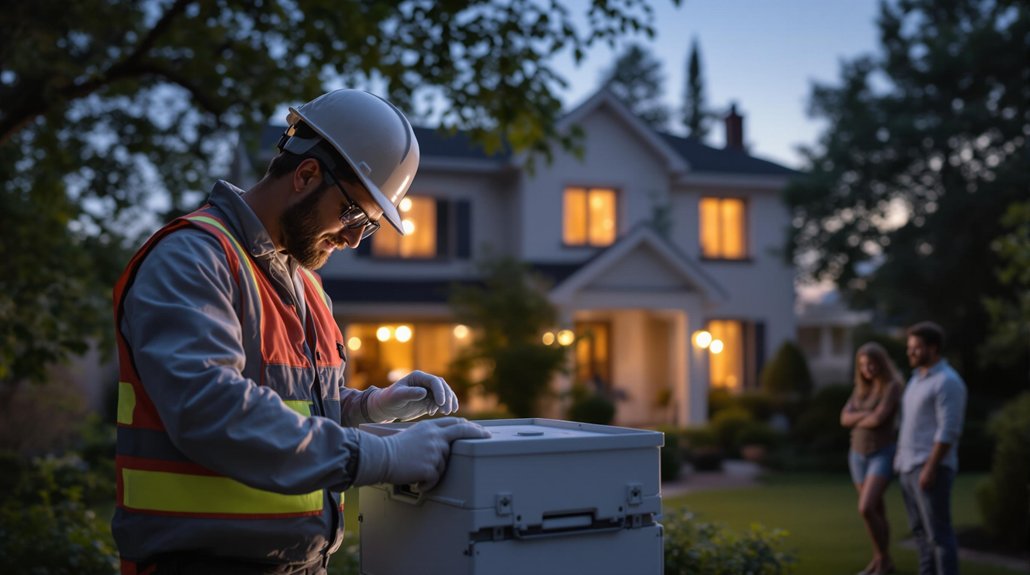When dealing with a bat infestation, calling a professional is often the best choice. Professionals know bat behavior and local laws, ensuring safe removal. Attempting DIY methods can be risky, as they may cause health problems or worsen the issue. There are legal considerations too, since many bat species are protected. Weighing the costs and risks of both options can help homeowners make an informed decision. More information is available to assist in this process.
Key Article Highlights
- Professional bat removal ensures compliance with local wildlife laws and regulations, reducing the risk of legal issues.
- DIY bat removal poses health risks from bites and exposure to hazardous droppings.
- Professionals have the expertise to safely and effectively remove bats, minimizing the chance of worsening the infestation.
- Hiring experts saves time and alleviates homeowner stress, providing peace of mind during the removal process.
- DIY costs may seem lower, but potential health risks and legal complications can lead to higher expenses in the long run.
Understanding the Risks of Bat Infestation
While many people may view bats as harmless creatures, understanding the risks of bat infestation is essential for homeowners. Bats can exhibit behavior that may lead to problems if they invade a home. Signs of infestation include droppings, strange noises at night, and dark stains on walls. These signs indicate that bats may be roosting in hidden areas, such as attics or walls. The presence of bats can create health risks, as they can carry diseases. Additionally, their droppings can damage property and create unpleasant odors. Homeowners must be aware of these infestation signs to safeguard their living spaces. Recognizing bat behavior helps individuals take action before a small issue becomes a significant problem. Understanding bat behavior is crucial for effective prevention and removal. Moreover, improper removal can cause the bats to become more aggressive or spread disease, emphasizing the importance of humane bat removal techniques.
Legal Considerations for Bat Removal
Bat infestations can lead to serious issues for homeowners, but removing them involves important legal considerations. Many regions have bat conservation laws that protect these animals due to their ecological benefits. Homeowners must understand these laws before attempting removal. Ignoring them can lead to fines or penalties. Additionally, wildlife control regulations often dictate how and when bats can be removed. It is crucial to check local regulations, as some areas may require permits or professional help for safe removal. Attempting to manage a bat problem without understanding these legal aspects may risk harm to the bats and the homeowner. Consequently, consultation with local wildlife authorities is recommended to guarantee compliance with the law.
Health Concerns Associated With Bats
How might the presence of bats affect human health? Bats can pose several health risks that people should be aware of. Their droppings, known as guano, can harbor harmful pathogens. Additionally, bats are known carriers of various diseases, increasing the risk of rabies transmission. Here are some health concerns associated with bats:
Bats pose health risks, including disease transmission and respiratory issues from their droppings. Stay informed and take precautions.
- Bat diseases can spread to humans and pets.
- Rabies transmission is a serious risk if bitten.
- Feces hazards can cause respiratory issues if inhaled.
- Allergic reactions may occur from bat droppings or urine.
Being informed about these risks is essential for anyone dealing with a bat presence. It is vital to take proper precautions to protect health and safety.
The Benefits of Professional Bat Removal

When dealing with a bat infestation, seeking professional removal services can offer significant advantages. First, experts have the benefits of expertise, ensuring they understand bat behavior and the best methods for removal. This knowledge helps to avoid mistakes that could worsen the situation. Additionally, professionals use safe removal techniques that protect both the bats and the home’s occupants. They follow local laws regarding wildlife, ensuring everything is done legally. Hiring a professional also saves time and reduces stress for homeowners who may not know how to handle the situation. Ultimately, entrusting this task to trained specialists can lead to a more effective and worry-free solution, allowing homeowners to reclaim their space without fear of harm or legal issues.
DIY Bat Removal: What You Need to Know
DIY bat removal can seem like a cost-effective option, but it comes with several risks. Homeowners need to understand effective techniques for safe removal and also consider any legal regulations regarding bats. Knowing these factors is important before attempting to handle a bat problem on one’s own.
Risks of DIY Removal
Removing bats from a home may seem like a straightforward task, but it carries significant risks. Many people underestimate the dangers involved in DIY bat removal. Without proper knowledge and equipment, they may encounter serious problems. Important risks include:
- Health Hazards: Bats can carry diseases like rabies, putting humans at risk.
- Injury: Attempting removal without safety precautions can lead to bites or falls.
- Improper Techniques: Using the wrong removal equipment can worsen the situation.
- Legal Issues: In some areas, bats are protected, and removal may violate laws.
For those seeking freedom from bats, understanding these risks is essential. Hiring professionals guarantees safety and effective removal without unnecessary danger.
Effective Removal Techniques
Effective bat removal requires careful planning and the right techniques. Many people prefer to handle this issue themselves to maintain their freedom. One effective method is using humane traps. These traps can safely capture bats without harming them. After capturing the bats, it is important to release them far from the home. Exclusion methods are also essential. This involves sealing any entry points to prevent bats from returning. Common entry points include gaps in roofs, walls, and vents. Homeowners should inspect their property thoroughly and make necessary repairs. Combining humane traps with exclusion methods can lead to successful bat removal. With proper techniques, individuals can reclaim their space without harming these creatures.
Legal Considerations Involved
Before attempting to remove bats from a property, individuals should be aware of the legal factors involved. Bats are protected under various laws, and improper removal can lead to legal trouble. Understanding these regulations is essential for anyone pondering DIY bat removal.
Key points to take into account include:
- Bat conservation laws may prevent removal during certain seasons.
- Wildlife protection regulations often require permits for handling bats.
- Local laws may dictate specific removal methods to guarantee safety.
- Penalties may be imposed for non-compliance with these regulations.
Being informed about these legal aspects can help individuals avoid fines and promote the humane treatment of bats. It is often wise to consult local wildlife authorities before taking action.
Cost Comparison: Professional Services vs. DIY
When considering bat removal, cost is an important factor. Professional services often come with higher fees due to their expertise and equipment. On the other hand, DIY methods can have lower upfront costs but may involve other expenses, such as tools and safety gear.
Professional Service Costs
Cost is a significant factor when deciding between professional bat removal services and a DIY approach. Professional pricing can vary widely based on location and service packages. Understanding these costs can help in making an informed choice.
Here are some typical costs associated with professional bat removal services:
- Initial inspection fees, often around $100 to $300
- Removal services may range from $200 to $1,500
- Exclusion and damage repairs can add another $200 to $1,000
- Follow-up visits might be included or charged separately
This information highlights the potential financial commitments involved when hiring professionals. Weighing these costs against the risks of DIY methods is essential for those seeking freedom from bat issues.
DIY Expenses Overview
Considering a DIY approach to bat removal can lead to various expenses that should be carefully evaluated. Homeowners must factor in DIY materials costs and tool rental expenses, which can add up quickly. Understanding these costs helps in making an informed decision.
| Expense Type | Estimated Cost | Notes |
|---|---|---|
| DIY Materials Costs | $50 – $200 | Includes sealants and traps |
| Tool Rental Expenses | $30 – $100 | For ladders and other tools |
| Total Estimated Cost | $80 – $300 | Varies based on needs |
Signs You Need to Call in the Experts
Although some may attempt to handle bat removal themselves, there are clear signs that indicate it’s time to seek professional help. Understanding bat behavior can be tricky, and ignoring infestation signs can lead to bigger problems.
Bat removal can be complex; knowing when to call professionals is crucial to prevent larger issues.
Here are some signs that you need to call in the experts:
- Frequent sightings of bats in or around the home
- Noises in the attic or walls, especially at dusk
- Guano (bat droppings) found in living spaces
- Strong, unpleasant odors from bat colonies
Recognizing these signs is vital. A professional can assess the situation safely and effectively. DIY methods may not address the root of the problem, which can lead to further issues and risks.
Frequently Asked Questions
Can Bats Harm My Pets During an Infestation?
Bats generally avoid confrontation, but their behavior can be unpredictable. In rare cases, they might harm pets if threatened. Pet safety is paramount; monitoring pets during a bat infestation is essential to prevent any incidents.
What Time of Year Is Best for Bat Removal?
The best time for bat removal aligns with bat migration patterns and seasonal behavior. Late summer and early fall are ideal, as bats are preparing to leave for warmer locations, reducing the chances of re-entry.
How Can I Prevent Bats From Returning After Removal?
To prevent bats from returning, effective bat proofing techniques and exclusion methods should be applied. Sealing entry points, installing screens, and using one-way doors can help keep these creatures from re-entering the space.
Are There Specific Tools Needed for DIY Bat Removal?
For DIY bat removal, essential tools include gloves, a mask, and a flashlight. DIY bat safety is vital; proper equipment helps protect against bites or disease while ensuring a humane and effective removal process.
What Should I Do if I Find a Bat Inside My Home?
When a bat unexpectedly enters a home, it resembles a lost sailor seeking refuge. Observing bat behavior, one should calmly contain the space for safe removal, allowing the creature to exit unharmed, preserving both freedom and safety.

